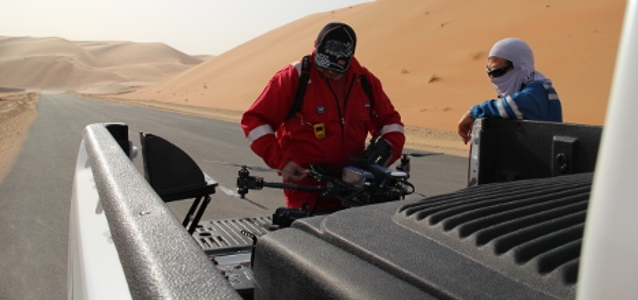
© skyeyeinnovations
Electronics Production |
'Drones can be used in more areas than just recreation and media'
Evertiq had a chat with the Swedish drone manufacturer Sky Eye Innovations. The company will integrate Flir's sensor solutions to reach new markets in the increasingly popular UAV-field.
Talking to co-founder and CEO Daniel Sällstedt, we discover that his background is quite broad: film and photography all the way to stints in several large IT firms. He also describes himself as a ”techie” - with a strong interest in all things technological. Together with Tomas Krejci he sat out to found Sky Eye. A project that they had worked together was exploring multi-copter solutions for camera-lifting. Tomas used to work for HAB Electronic AB, a company that sells and builds solutions for individuals with an interest in RC-solutions. "We found that both of us thought that we have more to do in this area. Tomas is good at hardware and technology solutions. I contribute with insights and identifying needs, packaging options, services along with the building of strategic alliances. We gave ourselves time to develop, iterate and thoroughly test our ideas. Combined with unique partnerships, we came up with a reliable product with exceptional performance and unique properties", Daniel Sällstedt tells Evertiq. Sky Eye found its niche in a new market In recent years, drones have received considerable attention from the media. The manoeuvrable multi-copter solutions have found their way into consumer hands and are currently employed by both the recreational and professional users. "We saw that drones could be used in more areas than just recreation and media. There has been an explosive growth in these markets, but we quickly saw that ’we can do something else.’ We can develop UAV platforms in an optimized way using heavier and more advanced sensor technology." Their sight fell on Flir Systems and their advanced sensor solutions. Sky Eye Innovations felt that they had more to offer than smaller and lighter sensors. The company has since worked to develop a platform optimized to take full advantage of Flir-sensors in thermography. "It started when we got in touch with Flir. We were invited to a meeting and had an opportunity to look at their cameras and sensors. While we began a dialogue, we also obtained a valid test panel. We worked closely with Södertörn's firefighting team (an urban area in the south of Stockholm). Who better to test our equipment than firefighters we thought. High requirements are placed on equipment and the test are rigorous during the qualification process." The rest has been polishing and optimising, a work that has continued up until 2015. Now the company has a global network of distributors, consisting mainly of Flir-distributors. Which customer groups are you focusing on? "We have mainly focused on the industry segment. This is a broad market that includes everything from oil and gas – both onshore and offshore – to solar parks, wind turbine parks, forest management and more. Actually, all areas where you can work with this sensor technology is interesting for us; where the combination of the UAV and sensor is useful. The starting point has been to replace people with technology in real hazardous situations, create visibility, control and thereby reduce the risk. This has resulted in solutions that are also profitable for the industry.""We found that both of us thought that we have more to do in this area. Tomas is good at hardware and technology solutions, says CEO Daniel Sällstedt"
The only field not being addressed is Military, says Daniel Sällstedt. “The drones exist 'for being used for achieving good'”. What about development and production? How much it have you kept in-house? Have you placed some of it with external partners? "There is a balance there. We have chosen to buy certain electronic components such as control systems and components that have a broad user community and thus a major test community. However, when it comes to the actual units, we build every machine ourselves. We can handle a limited volume in our existing production environment and we have plans to move production geographically if we exceed a certain volume. As it looks now, we want to keep production in-house, whether it takes place in Sweden or abroad." He continues: "It is also important to understand that we will not do everything ourselves. We cannot be experts on everything. There are valuable skills, in other individuals and companies, that we can take advantage of. Therefore, we prefer working with partners that are the best in their respective fields." Currently, the company is aiming at a production volume of around 100 units per year – everything built on an order basis. What exactly does the cooperation with Flir mean for you? "We have worked together with different people at Flir Systems for a long time. The goal was to learn and then develop solutions around their wide product range. The collaboration has given us unique knowledge about their technology and a better understanding of what problems technology can solve. It has also led to new relationships and good contacts with distributors. Our solution, in turn, drives new sales of Flir Systems products." "All our collaborations with different partners contribute with experience and expertise from their field. We also work closely with Termisk Systemteknik. They are experts in thermography and develop solutions in this area. For example, we don't want to be dependent on infrastructure. In many of the places and environments where our solutions are used, there is simply no infrastructure such as 3G, 4G, etc. Therefore, we have developed solutions that use radio technology to control the cameras - the same technology that we use for flying the machines. The software to control the sensors in this way is developed in collaboration with Termisk Systemteknik." What technology trends do you see that will drive you forward? ”The most exciting for us right now is the optical gas detection. We are the first in the world with drones that are able to see and detect gas leaks from the air. Our distributors and partners – in the US it is Viper Imaging and in the UK we work with InspectaHire Instruments – are well established in industries such as oil and gas. This is a solution that is completely new and makes a difference." ”In addition: we keep our eyes open at all time. There are many good initiatives out there, but we want to ensure that our solutions address the bigger issues. An example of what is important now is Collision Avoidance Systems." The company is currently looking at several solutions in this; LIDAR, real-sense technology, and ultrasound are just examples. ”It is important that we find the right technology that suits our platform. There are so many different solutions and therefore, it is difficult to know which road to take. LIDAR is the technology we watch the most. We believe that it will add functions other than just security to our solutions. It could, for instance, help us build graphical models.” At the same time he is convinced that the company must now focus on what they have right now and what they are marketing right now. "We will, however, constantly evaluate what is the next step." ----- Images: © Sky Eye Innovation







